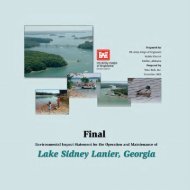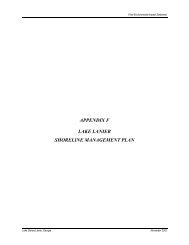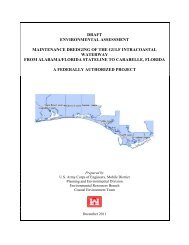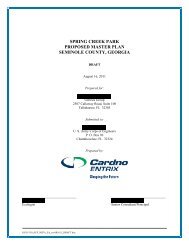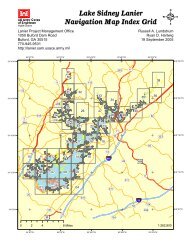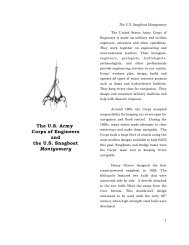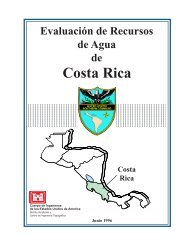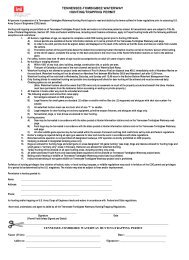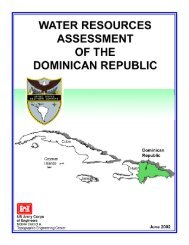Enclosure 11 CESAM SOP 1130-2-9 - Mobile District
Enclosure 11 CESAM SOP 1130-2-9 - Mobile District
Enclosure 11 CESAM SOP 1130-2-9 - Mobile District
You also want an ePaper? Increase the reach of your titles
YUMPU automatically turns print PDFs into web optimized ePapers that Google loves.
<strong>Enclosure</strong> <strong>11</strong><br />
<strong>CESAM</strong> <strong>SOP</strong> <strong>11</strong>30-2-9
DRAFT FEB 2005<br />
<strong>CESAM</strong>-OP-TR SAM <strong>SOP</strong> <strong>11</strong>30-2-9<br />
XX Month Year<br />
DEPARTMENT OF THE ARMY<br />
<strong>Mobile</strong> <strong>District</strong>, Corps of Engineers<br />
P.O. Box 2288<br />
<strong>Mobile</strong>, Alabama, 36628-0001<br />
Project Operations<br />
RESERVOIR REGULATION AND COORDINATION<br />
FOR FISH MANAGEMENT PURPOSES<br />
1. Purpose. To provide a standing operating procedure (<strong>SOP</strong>) to be followed by <strong>Mobile</strong><br />
<strong>District</strong> staff and selected Operations Division field offices to implement South Atlantic<br />
Division Regulation DR <strong>11</strong>30-2-16, Project Operations, Lake Regulation and<br />
Coordination for Fish Management Purposes. This <strong>SOP</strong> (1) identifies designated periods<br />
of time within which fish spawn operations will be conducted at specific projects, (2)<br />
establishes protocols for coordination between the U.S. Fish and Wildlife Service (FWS),<br />
State fisheries personnel, and the Corps, and (3) provides for development of an annual<br />
plan for special water management operations by the Corps, in coordination with the<br />
FWS and the State fisheries agencies, that would balance impacts and benefits to both<br />
reservoir and riverine fisheries during the spring fish spawning period. This <strong>SOP</strong> is<br />
intended to benefit multiple sport fish and forage fish species having similar spawning<br />
habits.<br />
2. Applicability. This <strong>SOP</strong> applies to the operation of Allatoona Lake, Okatibbee Lake,<br />
Lake Sidney Lanier, West Point Lake, Walter F. George Lake, Lake Seminole, and the<br />
Apalachicola River. In addition to project office staffs, technical and support staffs in the<br />
<strong>Mobile</strong> <strong>District</strong> Office have significant roles in the successful implementation of this<br />
<strong>SOP</strong>. Key offices are listed below.<br />
Operations Division<br />
Planning and Environmental Division<br />
Engineering Division<br />
Public Affairs Office<br />
OP-TR<br />
PD-EI<br />
EN-HW<br />
PA<br />
3. References.<br />
a. ER <strong>11</strong>30-2-540, Environmental Stewardship Operation and Maintenance<br />
Polices, Chapter 2, Natural Resources Stewardship.<br />
b. EP <strong>11</strong>30-2-540, Environmental Stewardship Operation and Maintenance<br />
Guidance and Procedures, Chapter 2, Natural Resources Stewardship<br />
This standing operating procedure supercedes <strong>District</strong> <strong>SOP</strong> <strong>11</strong>30-2-9 dated 23 Feb 1995
SAM <strong>SOP</strong> <strong>11</strong>30-2-9<br />
XX Month Year<br />
c. ER <strong>11</strong>30-2-550, Recreation Operation and Maintenance Polices, Chapter 3,<br />
Project Master Plans and Operational Management Plans.<br />
d. EP <strong>11</strong>30-2-550, Recreation Operation and Maintenance Guidance and<br />
Procedures, Chapter 3, Project Master Plans and Operational Management Plans.<br />
e. DR <strong>11</strong>30-2-16, Lake Regulation and Coordination for Fish Management<br />
Purposes.<br />
f. DR <strong>11</strong>30-2-18, Preparation of Operational Management Plan at Civil Works<br />
Water Resources Projects.<br />
4. Procedures.<br />
g. Executive Order 12962, Recreational Fisheries, 7 June 1995.<br />
In most water years it will not be possible to hold both reservoir levels and river stages at<br />
a steady or rising level for the entire spawning period, especially when upstream<br />
reservoirs and/or the Apalachicola River spawning periods overlap. Droughts and floods<br />
within the basin also present specific water management challenges. During the<br />
spawning period applicable to each water body (paragraph 4(b)), the Corps shall operate<br />
for generally stable or rising reservoir levels , in accordance with the guidance of DR<br />
<strong>11</strong>30-2-16, and generally stable or gradually declining river stages on the Apalachicola<br />
River, for approximately 4 to 6 weeks during the designated spawning period for the<br />
specified project area. Generally stable or rising levels are defined as not lowering the<br />
reservoir levels by more than 6 inches, with the base elevation generally adjusted upward<br />
as levels rise due to increased inflows or refilling of the reservoir. Generally stable or<br />
gradually declining river stages are defined as ramping down of ½ foot per day or less.<br />
When these management goals are not possible, impose an unreasonable compromise to<br />
other project purposes, or would conflict with other fish management concerns within the<br />
basin, the Corps shall consult with the State fishery agencies and the FWS on balancing<br />
needs within the system and minimizing the impacts of fluctuating reservoir or river<br />
levels. Modifications to fish spawn operations could include readjusting the base<br />
elevation for fish spawn operation purposes at a particular project, allowing a rapid<br />
lowering in elevation back to the base elevation or a readjusted elevation following a<br />
flood event, or other operational adjustments recommended by the interagency team to<br />
minimize impacts and/or enhance system-wide benefits. The Corps shall also consult<br />
with the State fishery agencies and the FWS on water management operations that would<br />
minimize fishery impacts and balance needs throughout the system for the remaining<br />
portions of the fish spawn periods. The Corps shall schedule management<br />
responsibilities that conflict with operating for stable or rising reservoir levels or<br />
relatively stable river stages outside the fish spawning period to the extent practicable,<br />
consistent with other applicable laws and regulations.<br />
a. In February of each year <strong>Mobile</strong> <strong>District</strong> staff representatives will meet with the<br />
fisheries biologists from Alabama, Florida, Georgia, Mississippi and the FWS to discuss<br />
- 2 -
SAM <strong>SOP</strong> <strong>11</strong>30-2-9<br />
XX Month Year<br />
projected spring and summer trends, anticipated hydrological conditions within the basin,<br />
success of the past year’s fish spawn, and ways to balance fisheries priorities between<br />
reservoir and river systems during the upcoming spawning season. An imbalance of prey<br />
and forage fish could occur following the second or third year of poor or unsuccessful<br />
spawning and recruitment, leading to poor sport fishing. Areas where the spawns were<br />
recently unsuccessful should be given higher priority for fish management operations<br />
under low water conditions.<br />
b. The periods during which the Corps shall operate to achieve the purposes of<br />
this <strong>SOP</strong> are as follows:<br />
Administrative Office<br />
Project/Water Body<br />
Principal Fish<br />
Spawning Period for<br />
Operational<br />
Consideration<br />
Walter F. George Lake 15 March – 15 May<br />
ACF PROJ MGMT OFFICE<br />
Lake Seminole<br />
01 March – 01 May<br />
Apalachicola River 01 April – 01 June<br />
ALLATOONA PROJ MGMT OFFICE Allatoona Lake 15 March – 15 May<br />
LANIER PROJ MGMT OFFICE Lake Sidney Lanier 01 April – 01 June<br />
OKATIBBEE PROJ MGMT OFFICE Okatibbee Lake 01 April – 01 June<br />
WEST POINT PROJ MGMT OFFICE West Point Lake 01 April – 01 June<br />
c. Project personnel shall contact local State fisheries management personnel<br />
responsible for their project areas prior to the initiation of the identified spawning period<br />
and keep in close contact with them throughout the spawning period. PD-EI shall contact<br />
and maintain coordination with the State of Florida fisheries management personnel<br />
regarding initiation and status of fish spawning on the Apalachicola River. Information<br />
regarding the actual progress of fish spawn (i.e., has started, is in progress, is in peak, or<br />
has ended) should be relayed by project personnel to the <strong>Mobile</strong> <strong>District</strong> Office through<br />
OP-TR, and reported to EN-HW and PD–EI during the weekly water management<br />
meetings.<br />
d. EN-HW will consider hydrologic conditions within the basin,<br />
recommendations from the State fisheries management agencies and FWS, and status of<br />
fish spawn at other locations within the basin to schedule fish spawn operations for each<br />
project area (reservoir or river system) within the basin. The goal will be to provide<br />
generally stable or rising levels on the reservoirs and/or generally stable or gradually<br />
declining river stages on the Apalachicola River for approximately 4 to 6 weeks during<br />
the spawning period identified for each water body. Efforts to minimize fishery impacts<br />
and balance fishery resource and other project needs within the basin during the<br />
remaining portions of the spawning periods will also consider recommendations from the<br />
State fishery management agencies and FWS. A summary of the status of fish spawn<br />
operations at each project (including date and elevation at initiation and completion of<br />
fish spawn operations) will be posted on the <strong>Mobile</strong> <strong>District</strong> Water Management website.<br />
- 3 -
SAM <strong>SOP</strong> <strong>11</strong>30-2-9<br />
XX Month Year<br />
e. EN-HW will notify the PA office when fish spawning season begins and will<br />
invite PA to specific weekly water management meetings when important decisions<br />
having public impact are likely to be made. PA will advise the news media within 24<br />
hours of notification of any specific water management actions that are potentially<br />
detrimental to the fish spawn, including an explanation of the reasons for the water<br />
management actions.<br />
f. OP-TR will maintain an updated list of State and FWS fisheries biologists for<br />
the lake and river projects. OP-TR personnel will attend weekly water management<br />
meetings during the spawning period, relay pertinent information relating to the status of<br />
fish spawn or other fish management concerns to EN-HW, PD-EI and PA, and send<br />
weekly, either by e-mail or telephone, water conditions data to appropriate State and<br />
FWS fisheries personnel. OP-TR and PD-EI will consult telephonically with State and<br />
FWS fisheries personnel as necessary, and include project personnel in the consultation<br />
as appropriate. Any significant decisions based on the weekly water management<br />
meetings will also be relayed telephonically or by email to State fisheries personnel,<br />
FWS, project personnel, and South Atlantic Division personnel by OP-TR. PD-EI will<br />
advise any environmental groups or other interested stakeholder groups of the proposed<br />
action. At the conclusion of the spawning period, OP-TR will forward a summary report<br />
of the annual fish spawn operations to State fisheries management agencies, FWS, and<br />
South Atlantic Division, with a copy to PD-EI.<br />
g. OP-TR, EN-HW, PD-EI and PA will coordinate directly with each other or<br />
call additional meetings as the need arises.<br />
Date ______________<br />
PETER F. TAYLOR, JR.<br />
Colonel, Corps of Engineers<br />
Commanding<br />
DISTRIBUTION: B<br />
- 4 -



